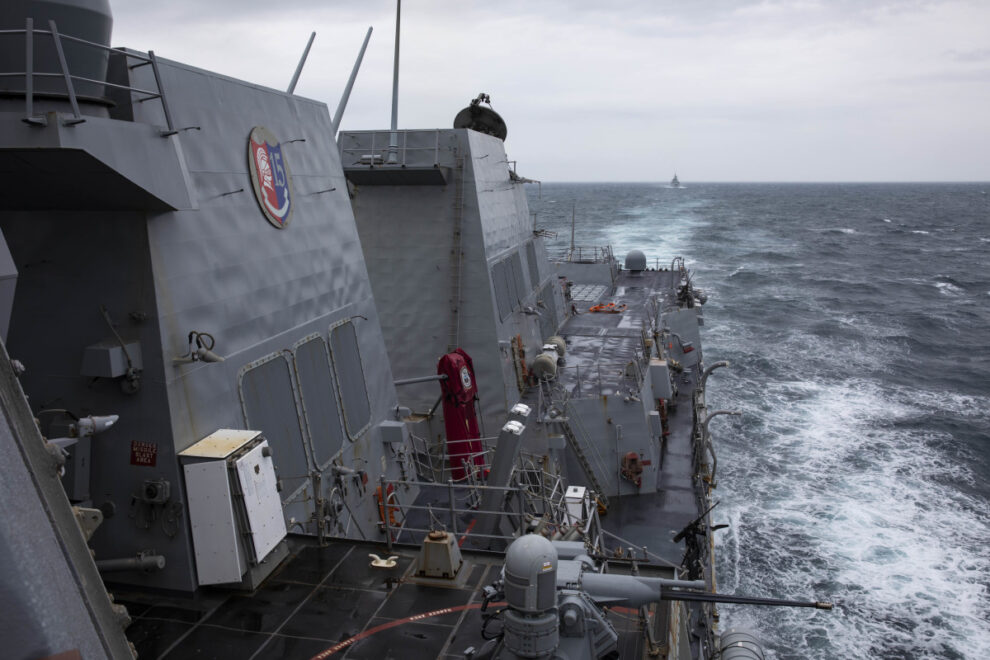The US Navy’s USS Ralph Johnson, a DDG 51 Arleigh Burke class destroyer, and a Royal Canadian Navy Halifax-class Frigate transited through the Taiwan strait
The US Navy is sending warship through the Taiwan Strait in a visible effort to demonstrate the power to freely sail anywhere international law allows and send China a signal that the Pentagon and its Pacific allies are prepared to defend Taiwan in the event of a Chinese attack.
The US Navy’s USS Ralph Johnson, a DDG 51 Arleigh Burke class destroyer, and a Royal Canadian Navy Halifax-class Frigate transited through the Taiwan strait in what a US Navy statement says was in “accordance with international law.”
“The ships transited through a corridor in the strait that is beyond the territorial sea of any coastal state,” a Navy essay says.
The Navy’s published language uses the term “high-seas freedoms of navigation” in a manner that seems to align its Taiwan Strait excursion in a manner entirely consistent with its long-standing FONOPS or Freedom of Navigation Patrols in and around the South China Sea.
US Navy “Forward Presence” & 5th-Generation Air Power
Pentagon Wargaming results of Pacific scenarios, coupled with multi-national training and war preparation exercises near Taiwan, consistently indicate the deterrence value of US Navy “forward presence” which places drones, warships. submarines and warship-launched aircraft within striking distance of Chinese forces and Taiwan. Certainly response time would be paramount to any effort to prevent a rapid Chinese annexation of Taiwan, something the Pentagon report cautions about and calls a “fait accompli” in which the PLA occupies Taiwan faster than its defenders can respond, making it too costly for any allied coalition to “extricate” an occupying Chinese force.
Taiwan Transit Clear Message to China
The transit, Navy language also specifies, is intended to ensure a “free-and-open” Pacific, a phrase which has been and continues to be aligned with South China Sea FONOPS. Although South China Sea FONOPS, which have been going on with varying levels of frequency for at least a decade, are decidedly pointed at transiting within the 12 mile territorial boundary of islands claimed by China to demonstrate that, in fact, the island or islands in question are not sovereign Chinese territory. This is quite significant, as the UN Law of the Sea Convention establishes that a given country’s territory ends out to 12 miles of surrounding ocean beyond its coastline. Therefore, sailing within that boundary of disputed islands China claims at their own is a deliberate attempt to demonstrate that China’s claims to much of the areas is illegitimate, phony or simply incorrect. China bases its territorial claims upon what it calls its “nine-dash-line,” a somewhat arbitrary territorial boundary China established more than 100 years ago in an effort to assert dominion over Spratly island and other regional territories going back many years to the days of the Kuomintang.
While the recent US Navy-Canadian Taiwan Strait transit did not sail within 12 miles of the Chinese or Taiwan coastline, it did represent a significant gesture in support of Taiwan independence. Also, the transit is also quite significant as a response to China’s continued training near Taiwan and growing air violations of Taiwan’s Air Defense Identification Zone. The Taiwan Strait is only 100 miles wide, so any presence there arguably puts Taiwan and mainland China within striking distance of ship-fired missiles and even helicopters or amphibious assault ship-launched F-35B 5th-generation air power. .
US Navy destroyers are armed with Tomahawk missiles and interceptors in position to strike targets on mainland China or, perhaps of greatest significance, potentially intercept or “knock out” Chinese ballistic missiles headed for the island of Taiwan. A US Navy destroyer-launched SM-2 or SM-6, for example, would be well positioned to destroy a Chinese ballistic missile should its Aegis radar establish a threat track. This might not stop any kind of massive Chinese salvo of ballistic missiles, something which would be part of a massive opening Chinese attack on Taiwan, yet the ability to track and destroy Chinese missiles approaching Taiwan is without question extremely significant to the deterrence equation.
Source : Warrior Maven






































